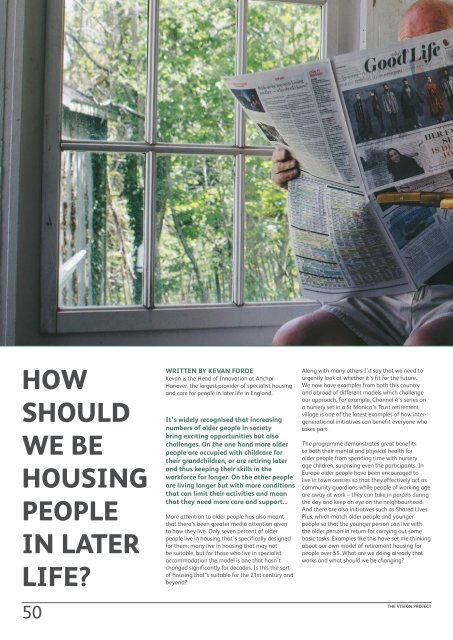The Vision Project
Throughout 2019, Developing Health & Independence (DHI), have been marking their 20th anniversary as a charity by looking to the future. Through articles, events and podcasts, they've asked people to answer the question of how we can achieve their vision of ending social exclusion. This collection of articles includes the contributions of experts from across public life and the political spectrum.
Throughout 2019, Developing Health & Independence (DHI), have been marking their 20th anniversary as a charity by looking to the future. Through articles, events and podcasts, they've asked people to answer the question of how we can achieve their vision of ending social exclusion. This collection of articles includes the contributions of experts from across public life and the political spectrum.
Create successful ePaper yourself
Turn your PDF publications into a flip-book with our unique Google optimized e-Paper software.
HOW<br />
SHOULD<br />
WE BE<br />
HOUSING<br />
PEOPLE<br />
IN LATER<br />
LIFE?<br />
50<br />
WRITTEN BY KEVAN FORDE<br />
Kevan is the Head of Innovation at Anchor<br />
Hanover, the largest provider of specialist housing<br />
and care for people in later life in England.<br />
It’s widely recognised that increasing<br />
numbers of older people in society<br />
bring exciting opportunities but also<br />
challenges. On the one hand more older<br />
people are occupied with childcare for<br />
their grandchildren, or are retiring later<br />
and thus keeping their skills in the<br />
workforce for longer. On the other people<br />
are living longer but with more conditions<br />
that can limit their activities and mean<br />
that they need more care and support...<br />
More attention to older people has also meant<br />
that there’s been greater media attention given<br />
to how they live. Only seven percent of older<br />
people live in housing that’s specifically designed<br />
for them; many live in housing that may not<br />
be suitable, but for those who live in specialist<br />
accommodation the model is one that hasn’t<br />
changed significantly for decades. Is this the sort<br />
of housing that’s suitable for the 21st century and<br />
beyond?<br />
Along with many others I’d say that we need to<br />
urgently look at whether it’s fit for the future.<br />
We now have examples from both this country<br />
and abroad of different models which challenge<br />
our approach. For example, Channel 4’s series on<br />
a nursery set in a St Monica’s Trust retirement<br />
village is one of the latest examples of how intergenerational<br />
initiatives can benefit everyone who<br />
takes part.<br />
<strong>The</strong> programme demonstrates great benefits<br />
to both their mental and physical health for<br />
older people from spending time with nursery<br />
age children, surprising even the participants. In<br />
Europe older people have been encouraged to<br />
live in town centres so that they effectively act as<br />
community guardians while people of working age<br />
are away at work – they can take in parcels during<br />
the day and keep an eye on the neighbourhood.<br />
And there are also initiatives such as Shared Lives<br />
Plus, which match older people and younger<br />
people so that the younger person can live with<br />
the older person in return for carrying out some<br />
basic tasks. Examples like this have set me thinking<br />
about our own model of retirement housing for<br />
people over 55. What are we doing already that<br />
works and what should we be changing?<br />
THE VISION PROJECT




